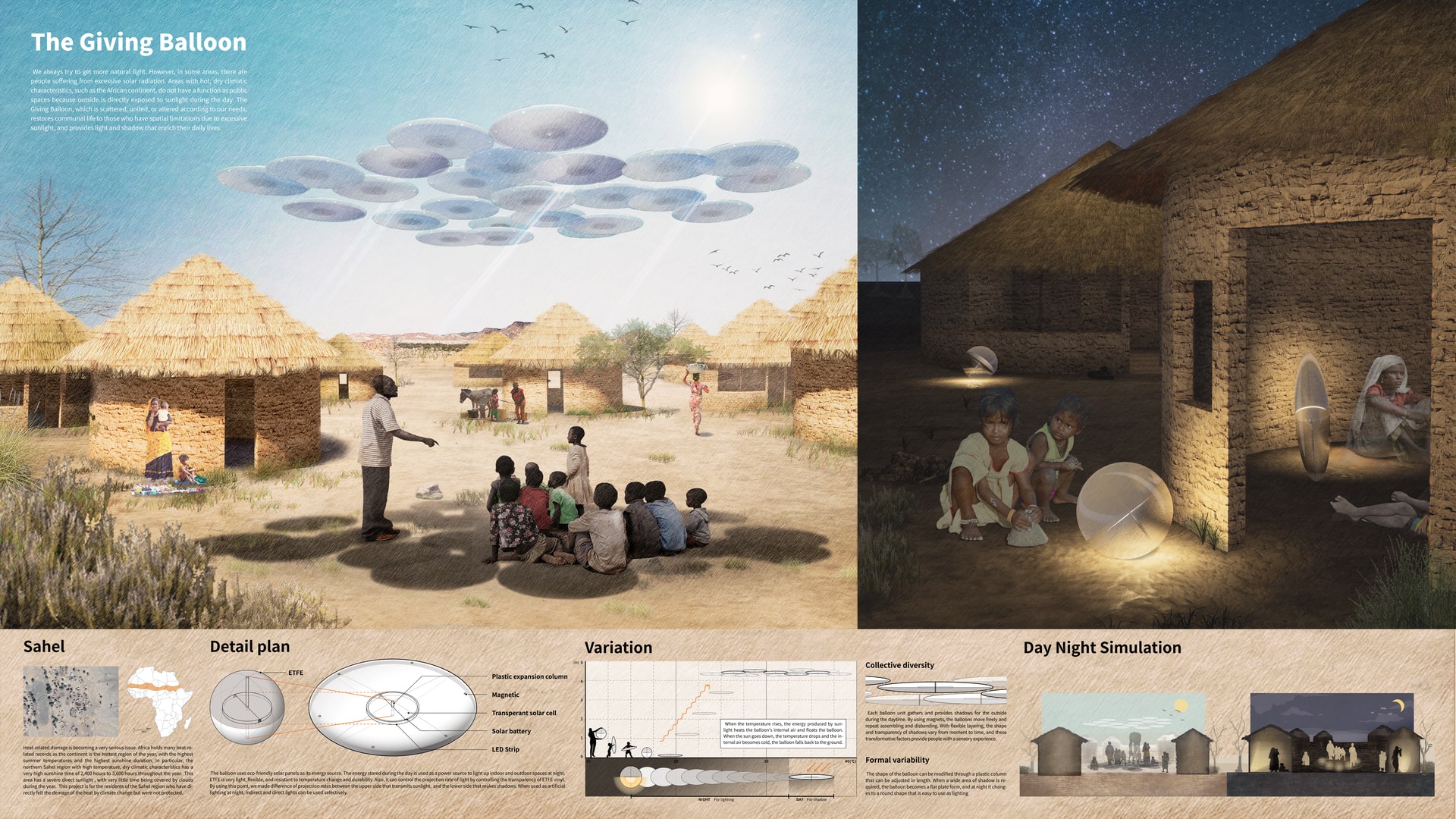Project Description
We always try to get more natural light. However, in some areas, there are people suffering from excessive solar radiation. Areas with hot, dry climatic characteristics, such as the African continent, do not have a function as public spaces because outside is directly exposed to sunlight during the day. The Giving Balloon, which is scattered, united, or altered according to our needs, restores communal life to those who have spatial limitations due to excessive sunlight, and provides light and shadow that enrich their daily lives. Sahel region Heat-related damage is becoming a very serious issue with the heat-related deaths averaging No. 1 for 30 years among climate-related deaths caused by desertification and abnormal weather conditions.(Source: Centers for Disease Control and Prevention). Africa holds many heat-related records as the continent is the hottest region of the year, with the highest summer temperatures and the highest sunshine duration. In particular, the northern Sahel region (southern Sahara) with high temperature, dry climatic characteristics has a very high sunshine time of 2,400 hours (about 55% of the time of day) to 3,600 hours (more than 80% of the time of day) throughout the year. This area has a severe direct sunlight (a solar radiation reaching the surface directly from the sun without being absorbed or scattered by atmospheric water vapor or small dust), with very little time being covered by clouds during the year. We worked on this project for the residents of the Sahel region who have directly felt the demage of the heat by climate change but were not protected. The Possibilities of "The Giving Balloon" The Giving Balloon has three possibilities: 1. Collective Diversity Each balloon unit gathers and provides shadows for the outside during the daytime, and is disbanded again at night to act as a light source for lighting up the indoor and outdoor spaces. The outer space always has the potential to be an open space by transforming it into a flexible space to the sunlight regardless of weather or time. It is assumed that each household owns 1-2 units, and the village of 20 households provides up to 33 square meters of shade. Each unit has a total of 12 magnets, six on the top and bottom side. By these magnets, the balloons move freely and repeat assembling and disbanding. With flexible layering, the shape and transparency of shadows vary from moment to time, and these transformative factors provide people with a sensory experience. 2. Formal variability The shape of the balloon can be modified through a plastic column that can be adjusted in length. During the daytime when a wide area of shadow is required, the balloon becomes a flat plate form, and at night when indoor and outdoor light supply is required, it changes to a round shape that is easy to use. Balloons are shaped differently depending on the situation, with the same volume. 3. Sustainability The balloon uses eco-friendly solar panels as its energy source. Inside the balloon there are transparent solar panels, batteries and controllers that store and transmit power. When the temperature rises during the day, the energy produced by sunlight heats the balloon's internal air and floats the balloon. When the sun goes down, the temperature drops and the internal air becomes cold, the balloon falls back to the ground. The energy stored during the day is used as a power source to light up indoor and outdoor spaces at night. ETFE(Ethylene Tetra fluoro Ethylene), used as the outer shell of a balloon, has material properties that are very light, flexible, and resistant to temperature change and durability. Above all, we actively utilized the fact that it can control the projection rate of light by controlling the transparency of ETFE vinyl. It has difference of projection rates between the upper side that produces energy by exposing as much sunlight as possible, and the lower side that makes shadows. When used as artificial lighting at night, indirect and direct lights can be used selectively. Conclusion The earth is heating up fast. Not only Sahel, but even at this moment, people look for shade to avoid the hot summer sun. And still, many children spend the night in poor electricity supply. Just as "spacialization of the shadow" has the potential to create a community beyond the space for coolness, we hope that the small gesture of light we propose will spark greater value than that. Like the giving tree in a fairy tale. The transition of our little ideas from two sides of light will present another possibility for "the light of tomorrow.“
